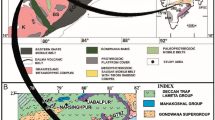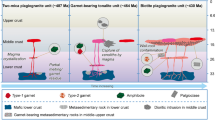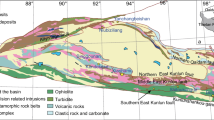Abstract
The field relations, mineralogy, and major and trace elements (including REE analyses of whole-rock samples and minerals) of granites and their associated molybdenite + uranium mineralized aplites in Southeastern Desert, Egypt, have been studied. The granites are leucocratic and mostly peraluminous in nature with muscovite increasing at the expense of biotite. The chemical and mineralogical characteristics of the granitic rocks indicate that their melts originated from the LILE-enriched mantle wedge by partial melting and are contaminated by crustal melts, followed by thermogravitational processes. Leucogranites with higher Na2O/K2O ratios from Um Dargag and Um Maiat crystallized under H2O-saturated equilibrium conditions in which the exsolved vapor continuously migrated away. The REE patterns of the granites studied are characterized by LREE enrichments and negative Eu anomalies. In comparison, the potassic aplites and the more sodic leucogranites are depleted in LREE, enriched in HREE and show more remarkable negative Eu anomalies. Allanite and monazite are the most important REE carriers in the granites. These minerals are strongly enriched in LREE, whereas fluorite and xenotime, which are more abundant in the aplites, are enriched in HREE. The average Lu/Ce ratio represents the fractionation trend with respect to HREE. It is 0.71 for radioactive fluorite, and it increases to 1.22 for non-radioactive fluorite. The high REE contents of molybdenite represent re-deposition of the mobilized Mo and REE. Due to the strong control of accessory minerals, the REEs are of limited use in petrogenetic modelling of highly evolved granitic systems.
Similar content being viewed by others
References
Alexander G.P. (1996) The Rare Earth in Apatites and Calcites from Iron Deposits of Angara—Ilim Type (the Siberian Platform) [C]. pp.480. Heidelberg Ger J of Goldschmidt Conf.
Balashov Y.A. and Krigman L.D. (1975) The effects on alkalinity and volatiles on rare earth separation in magmatic systems [J]. Geochemical International. 12, 165–170.
Batchelor R.A. and Bowden P. (1985) Petrogenetic interpretation of granitoid rock series using multicationic parameters [J], Chemical Geology. 48, 43–55.
Bau M. and Moller P. (1992) Rare earth element fractionation in metamorphogenic hydrothermal calcite, magnesite and siderite [J]. Mineral Petrology. 45, 231–246.
Bilal B.A., Herrmann F. and Fleischer W. (1979) complex formation of trace elements in geochemical system 1. Potentiometric study of fluoro-complex of rare earth elements in fluorite bearing model system [J]. J Inorganic Nuclear Chemistry. 4, 88–397.
Boynton W.V. (1984) Cosmochemistry of the rare earth elements: Meteorite studies. In Rare Earth Element Geochemistry (ed. P. Henserson) [M]. pp.63–114. Elsevier, Amsterdam.
Cathelineau M. (1988) Accessory mineral alteration in peraluminous granites at the hyrothermal stage: A review [J]. Rendiconti Della Societa Itallana Di Mineralogia E Petrologia. 43/2, 499–508.
Cullers R.L. and Graf J.L. (1984) Rare earth elements in igneous rocks of the continental crust: Intermediate and silicic rocks ore petrogenesis. In Rare Earth Element Geochemistry (ed. P. Henderson) [M]. pp. 275–316. Elsevier, Amsterdam.
Debon F. and Le Fort P. (1983) Achemical-mineralogical classification of common Plutonic rocks and association [J]. Trans R Soc Edinburgh Earth Science. 73, 135–149.
Deer W.A., Howie R.A., and Zussman J. (1992) An Introduction to the Rock Forming Minerals (2nd edition) [C]. Longman Sci Tech London. 70, 148–160.
Drysdall A.R., Jackson N.J., Ramsay C.R., Douch C.J., and Hacket D. (1984) Rare element mineralization related to Precambrian alkali granites in the Arabian Shield [J]. Economic Geology. 79, 1366–1377.
England R.W. (1992) The genesis, ascent, and emplacement of the Northern Arran granite, Scotland: Implication for granitic diapirism [J]. Geologic Society of America. 104, 606–614.
Eppinger R.G. and Closs L.G. (1990) Variation of trace elements and REEs in fluorite: A possible tool for exploration [J]. Economic Geology. 85, 1896–1907.
Fleischer M. (1969) The Lanthanide Elements in Fluorite [M]. pp.123. Indian Miz.
Flynn R.T. and Burnham C.W. (1978) An experimental determination of rare earth partition coefficients between a chloride containing vapour phase and silicate melts [J]. Geochimica et Cosmochimica Acta. 42, 685–701.
Gramenitskity E.N. and Shchekina T.I. (1996) The Ore Components Concentration at Magmatic Stage in the Granite System [C]. pp.210. Heidelberg Ger J of Goldschmidf Conf.
Hanson G.N. (1978) The application of trace elements to the petrogenesis of igneous rocks of granitic composition [J]. Earth Planet Sci Lett. 38, 26–43.
Henderson P. (1984) General geochemical properties and abundances of the rare earth elements. In Rare Earth Element Geochemistry (ed. P. Henderson) [M]. pp.1–32. Elsevier, Amsterdam.
Huang D.H., Nie F.J., Wang Y.C., and Jiang X.J. (1985) Petrologic characteristics and petrogenesis of the granitoids in the Jinduicheng-Huanglongpu district and their relation to molybdenum deposit [J]. Bull Institute Mineral Deposits, Chinese Academy Geology Science. 16, 96–126 (in Chinese with English abstract).
Hughes C.J. (1971) Metasomatism in the late Precambrian Bull Arm formation of southeastern Newfoundland [J]. Economic Geology. 57, 240–255.
Jebrack M., Smejkal V., and Albert D. (985) Rare earth and isotopic geochemistry of fluorite-barite vein deposits from western Rouergue district (France) [J]. Economic Geology. 80, 2030–2034.
Landenenberger B. and Collins W.J. (1996) Derivation of A-type granites from adehydrated charnockitic lower crust: Evidence from the chaelundi complex Eastern Australian [J]. Journal of Petrology. 37, 145–170.
Mahood G. and Hildreth W. (1983) Large partition coefficients for trace elements in high silica rhyolites [J]. Geochimca Acta. 47, 11–30.
Marshall A.S., Hinton R.W., and Macdonald R. (1998) Phenocrystic fluorite in peralkaline rhyolites Olkaria Kenya Rift Valley [J]. Mineralogical Magazine. 62, 477–486.
Mckay G. (1989) Partitioning of REE between major silicate minerals and basaltic melts [J]. Reviews in Mineralogy and Geochemistry. 21, 45–77.
Miller C.F. and Mittlefehldt D.W. (1984) Extreme fractionation in felsic magma chambers: A product of liquid-state diffusion or fractional crystallization [J]. Earth Planet Science Letters. 68, 151–158.
Mittlefehldt D.W. and Miller C.F. (1983) Geochemistry of the Sweetwater Wash Pluton, California: Implications for “anomalous” trace element behaviour during differentiation of fesic magmas [J]. Geochimica et Cosmochimica Acta. 47, 109–124.
Nagasawa H. (1970) Rare earth concentrations in zircons and apatites and their host dacites and granites [J]. Earth Planet Science. 9, 359–364.
Nash W.P. and Crecraft H.R. (1985) Partition coefficients for trace elements in silicic magmas [J]. Geochimica et Cosmochimica Acta. 49, 2309–2342.
Noyes H.J., Frey F.A., and Wones D.R. (1983) Mantle of two plutons: Geochemical evidence bearing on the origin and differentiation of the Red lake and Eagle Peak Plutons, central Sierra Nevada California [J]. Journal of Geology. 91, 487–509.
Pagel M. (1982) The mineralogy and geochemistry of uranium, thorium and rare-earth elements in two radioactive granites of the Vosges, France [J]. Mineralogical Magazine. 46, 149–161.
Pearce J.A., Harris N.B.W., and Tindle A.G. (1984) Trace element discrimination diagram for the tectonic interpretation of granitic rocks [J]. J Petrol. 25, 956–983.
Schnetzler C.C. and Philpotts J.A. (1970) Partition coefficients of rare-earth elements between igneous matrix and rock-forming phenocrysts [J]. Geochimica et Cosmochimica Acta. 34, 331–340.
Streck J.M. (1997) High-silica rhyolite differentiation processes in the light of mineral partition coefficients from Rattlesnake Tuff, Oregon [J]. Journal of Petrology. 38, 133–163.
Taylor R.P. and Fryer B.J. (1982) Rare earth element geochemistry as an aid to interpreting hyrothermal ore deposit. In Metallization Associated With Acid Magmatism (ed. A.M. Evans) [M]. pp.357–365. Wiley, New York.
Thompson M. and Walsh J.N. (1983) A Handbook of Inductively Coupled Plasma Spectrmetry [M]. pp.273. Blackie, London.
Tumenbayar E. and Smirnova Y.V. (1985) Yttrium and Ytterbium distribution in fluorite from East Mongolian Mesozoic granitoids and post-magmatic deposits [J]. Geochemical International. 22, 66–69.
Von Platen H. (1965) Kristallisation granitscher Schmelzen [J]. Contributions of Mineralogy and Petrology. 11, 341–381.
Wedepophl K.H. (1995) The composition of the continental crust [J]. Geochimica et Cosmochimica Acta. 59, 1217–1232.
White W.H., Bookstrom A.A., Kamilli R.J., Ganster M.W., Smith R.P., Ranta D.E., and Steininger R.C. (1981) Character and origin of climax-type molybdenum deposit [J]. Economic Geology. 75, 270–216.
Winkler H.G.F. (1976) Petrogenesis of Metamorphics Rocks [M]. pp.334. Springer, New York.
Author information
Authors and Affiliations
Corresponding author
Rights and permissions
About this article
Cite this article
Saleh, G.M. Geology and rare-earth element geochemistry of highly evolved, molybdenite-bearing granitic plutons, Southeastern Desert, Egypt. Chin. J. of Geochem. 26, 333–344 (2007). https://doi.org/10.1007/s11631-007-0333-y
Received:
Accepted:
Issue Date:
DOI: https://doi.org/10.1007/s11631-007-0333-y




